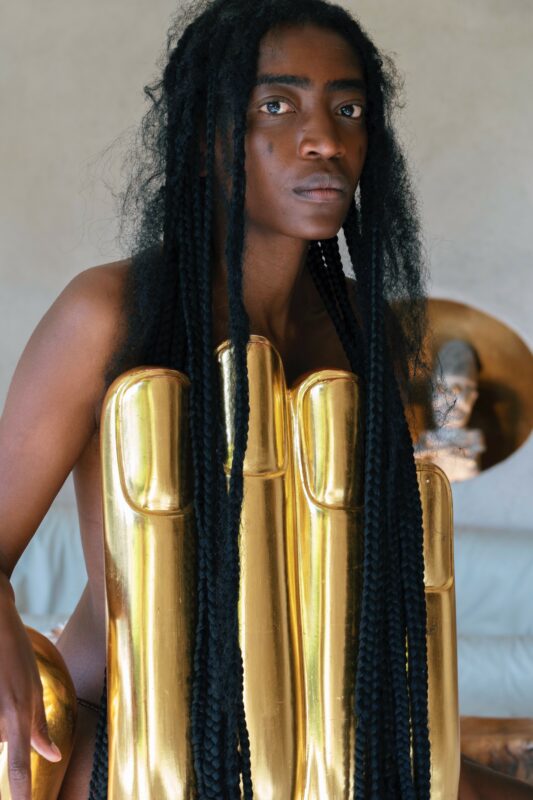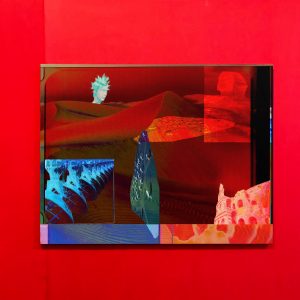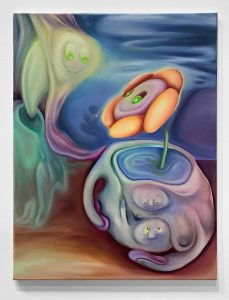
Rachel Rosheger is a visual artist who is interested in the conversion of energy. She has invested her time in electric particles, natural and manufactured. Rosheger’s work explores the quest for transcendence within machinery and humans’ desire to harness elements of nature. Rosheger creates artworks utilizing apparatuses from meteorology and appropriated footage from storm chasers to further propel her understanding of the climate of human advancement in an ever-changing physical landscape.
Rosheger holds a BFA from Cooper Union. She has exhibited at Microscope Gallery, New York, Parent Company, New York, Lower Cavity, Massachusetts, Harkawik, New York, Fragment Gallery, New York, and As It Stands, Los Angeles, among others.
Rosheger currently lives and works in New York City. She currently has work included in the exhibition Sell the Farm at SARA’S and will be included in two upcoming exhibitions with Family Gallery, Montreal, Canada, and Fall River Museum of Contemporary Art, Fall River, MA.
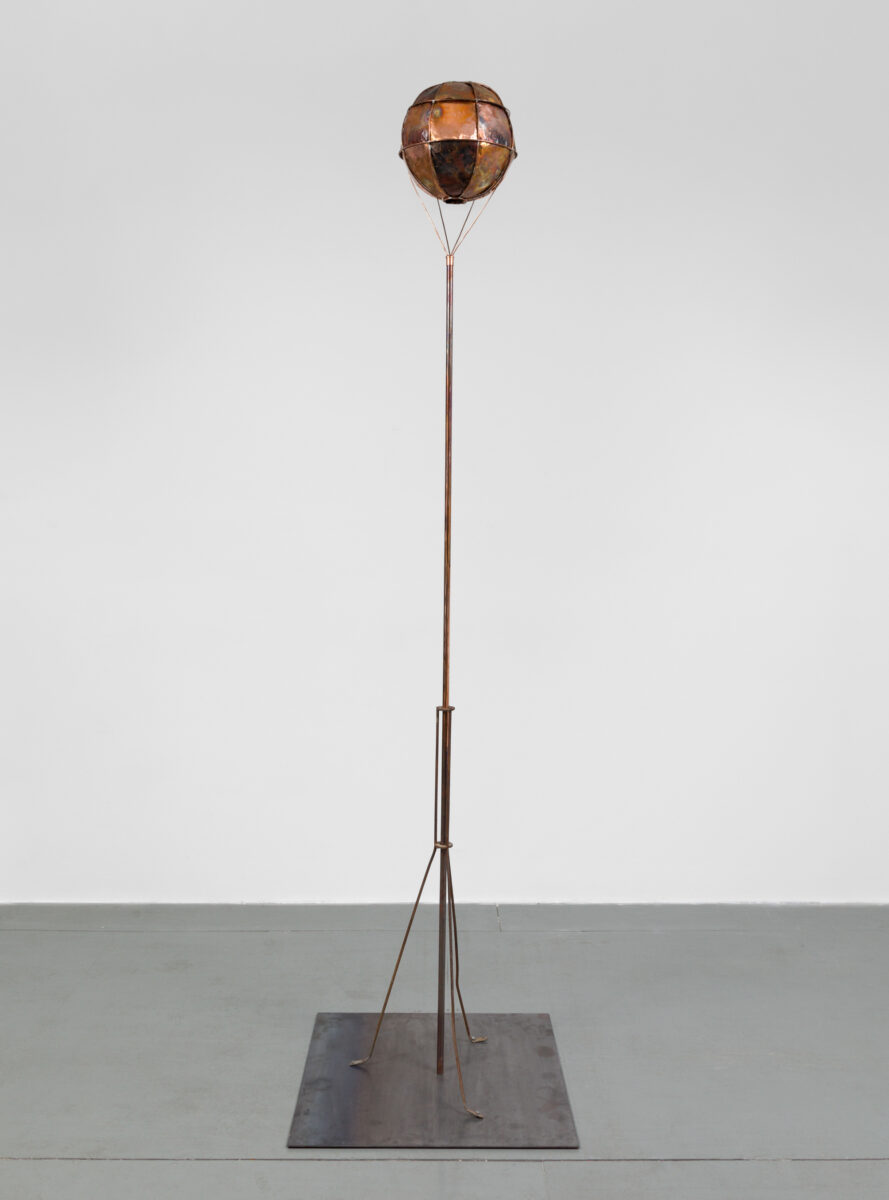
Phillip Edward Spradley: You began your artistic explorations in drawing and painting and rebelled against your own structures when you stumbled upon avant-garde film. These films further inspired you to create video work, and you transitioned further into sculpture because, at the time, you did not think you could produce the physicality you wanted to see in your artwork on a 2D surface. How did you then process your move from single-channel video works to the LED sculptures you create?
Rachel Rosheger: I was really enthusiastic about video because it felt like this uncharted realm. There was also great energy around it at Cooper Union-in part because Lucy Raven had just been brought on as full time faculty. I was working on some pretty intensive video projects and at a certain point I felt unsatisfied materially with the confines of mediated space. It didn’t reflect my full experience with the world. I became sort of obsessed with this tension, with mediated experience, and the question of matter and the digital. The LEDs and my sculpture practice ultimately arose from this.

P.E.S.: The LED screens you use for your sculptures are fragments from larger jumbotrons; each LED light amounts to a pixel, and the videos are a constellation of moving images shown on a low-resolution display. How does the deconstruction of these larger images and material allow you to communicate your metaphysical life of nature and existence?
R.R.: For me this sort of breakdown of the screen was a direct confrontation of the materiality of video, both in the nature of the LED panels themselves, and in the way that I use them as sculptural objects. The tension between space and content is really tangible with these screens. Because I’m putting high resolution video onto panels of lights that are around 32 x 64 pixels, you need distance to decipher it. Your body’s proximity to them majorly determines the legibility of the image. Close up, they read as abstract motion, color, and light, but not as a blur, as individual lights. It presents the mechanisms of moving images in a way that we often aren’t considering.
And then perhaps even more importantly, in order to use the LED technology, I had to engage with electricity in a way I never had. Working with video now not only through mediation, but also through concrete matter was this huge moment for me. I really think this is key to what led me to my interest in energy systems and machines because for me it was now no longer just about content. It was about the apparatus, and even further than that, raw materials that make that content possible. So then I guess, this became sort of the essential question for me and my practice.
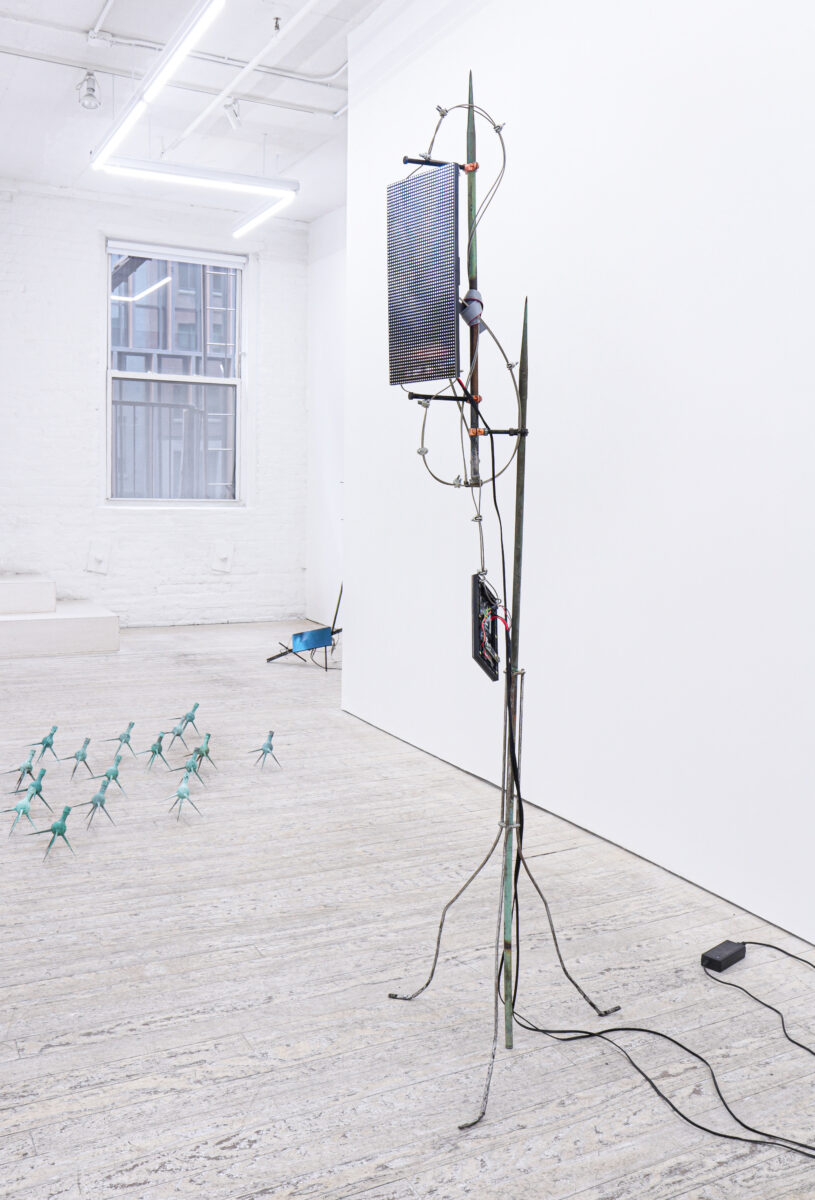
P.E.S.: What is your media diet? Where do you look for information that explores aspects of your work?
R.R.: It’s mostly YouTube, internet forums, and also Pinterest. Weirdly I have found Pinterest algorithms to be amazing for the content I’m interested in, which is largely DIY machines and alternative energy systems, electro-experiments, survivalist and off-grid culture, and things of this nature.
And then YouTube is huge for me. It’s where I exclusively source my appropriated video content, particularly storm chaser channels-which is the primary content of the LED works. The storm chaser is this character I’m really invested in that is seeking transcendence through the awesome forces of the Great Plains. Across the board, I’m interested in parts of the internet where people are looking for escape routes.
P.E.S.: You are performing ongoing research on perpetual motion machines, which were primarily invented in the 17th and 18th centuries. Inventors and amateurs would fabricate “free energy machines”; they were presented as real, but none successfully worked, even though some were patented. This effort of creation still takes place, primarily revealed on YouTube with special effects and edited footage. What is the aesthetic and broader culture that you appreciate from these alt-machines?
R.R.: All of these devices defy the laws of thermodynamics. On the one hand there is the deceptive quality which is amusing, but then there is also a genuine pursuit of the impossible, a quest for the infinite, and a sort of defiance of the limitations of nature. It’s both an imaginative escapism from the feeling of disenfranchisement with the technologies that define our lives as well as a cultivation of wonder, magic, and awe. And there is a desire for a kind of autonomy or sovereignty within this.
And I also like the absurd and rebellious quality of the celebration of failed devices. There’s a phenomenon where occasionally these machines slip under the nose of the US Patent and Trademark Office and still get patented. There’s something about that I just love. Within the deceptive aspect, I like the levels of uncertainty of who believes the claim and who is playing along, particularly in comment sections.
It also got me thinking about our relationship to energy more generally, and I would argue we all believe in free energy because the way that we think about and use energy is as if these inventors’ claims are in fact true. Our dominant modes of production are ecologically destructive because they aim at the infinite extraction of value and expenditure without thinking about their trajectories. Free energy appeals to a logic that doesn’t factor in concepts of waste.

P.E.S.: The preliminary graphite sketches made for your sculptures brought you back into drawing as a final result. The first you exhibited silverpoint drawings was at your exhibit Gone Before You Get There at Microscope Gallery, where you were capturing ghostliness, which further highlights your interest in motion and the transference of energy. Can you share how you came into the medium of silverpoint and the qualities you appreciate about it?
R.R.: Silverpoint is this strange, obsolete medium where you use an actual piece of silver to make marks. I love the simplicity-all you have is the piece of metal and the substrate. You can’t erase, the tonal range is limited, and it is luminous. It felt conducive to the subject matter I was trying to depict, which was things being swept away. I liked that I couldn’t use actual erasure to depict this, any removal had to be in the mark itself.
Additionally, the mark-making I’m exploring is very urgent and has a lot of movement. This is uncommon with silverpoint. I’m taking something which symbolizes permanence–metal–and making it feel ephemeral, which is a theme I’m exploring throughout my work. Also, since it is actual silver in the paper, it tarnishes. Over time, the marks deepen and even change hue in relation to atmospheric conditions. It’s alive. This indexical connection to air is something I’m really interested in. And then my work is all about electricity, and silver is the most conductive metal.
P.E.S.: You have a very “natural” and pure color palette in that you utilize raw materials and various macantics and allow these elements to emit their energy. These tonal expressions are embedded in our lives and can further our relationships, awareness, and experience of the spaces in which we live. How do you see the relationship of your surrounding urban environment affecting your attitude towards your disciplined use of tone?
R.R.: A lot of the colors and surfaces that emerge in my work come from the weathering and decay of the materials we rely on for our modern existence. My focus is on metal particularly because it is something we see as rugged, but I’m focused on its vulnerability. It is a resource that we are taking from the depths of the earth and exposing to the atmosphere-a reality which causes corrosion, the destruction of the integrity of the material. So I think maybe there is a sense of sadness or loss in this palette. Life is a process of involuntary oxidation.
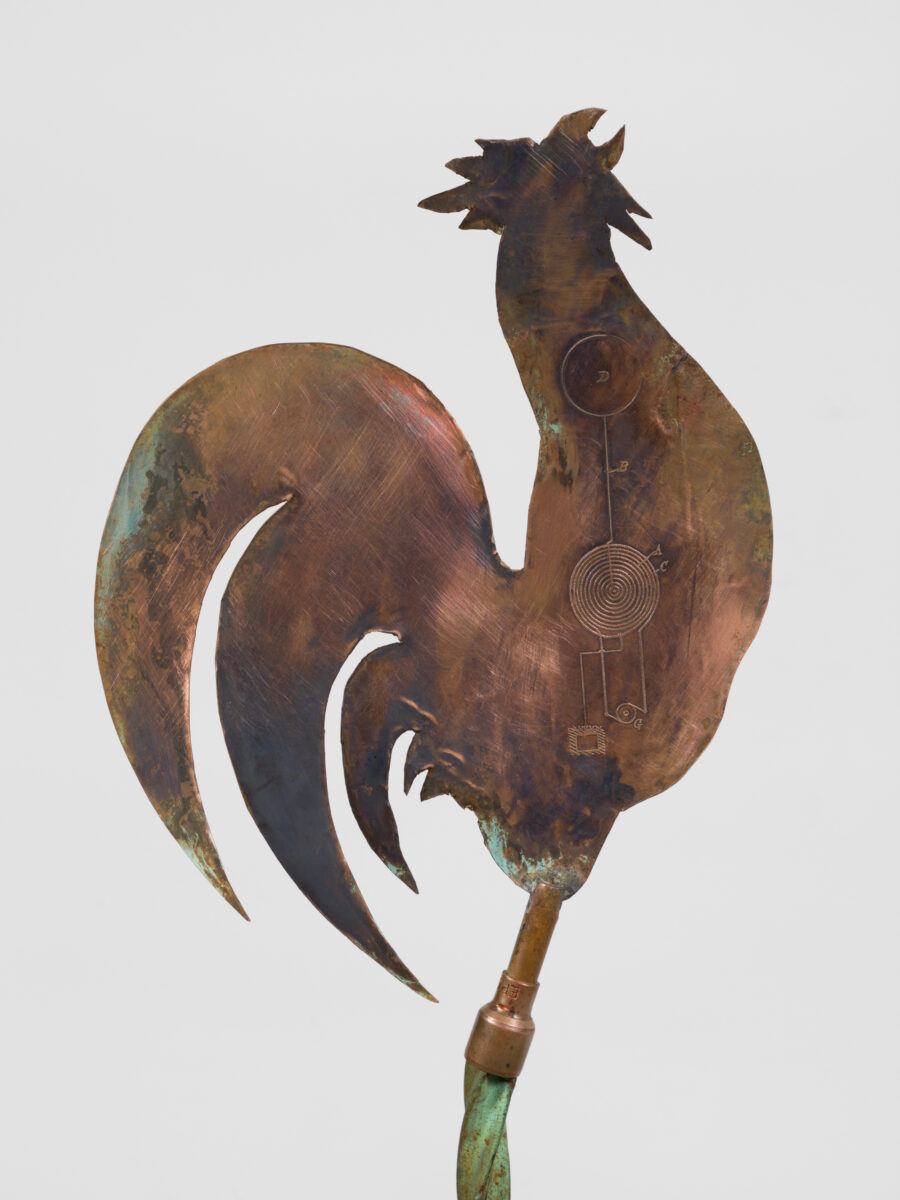
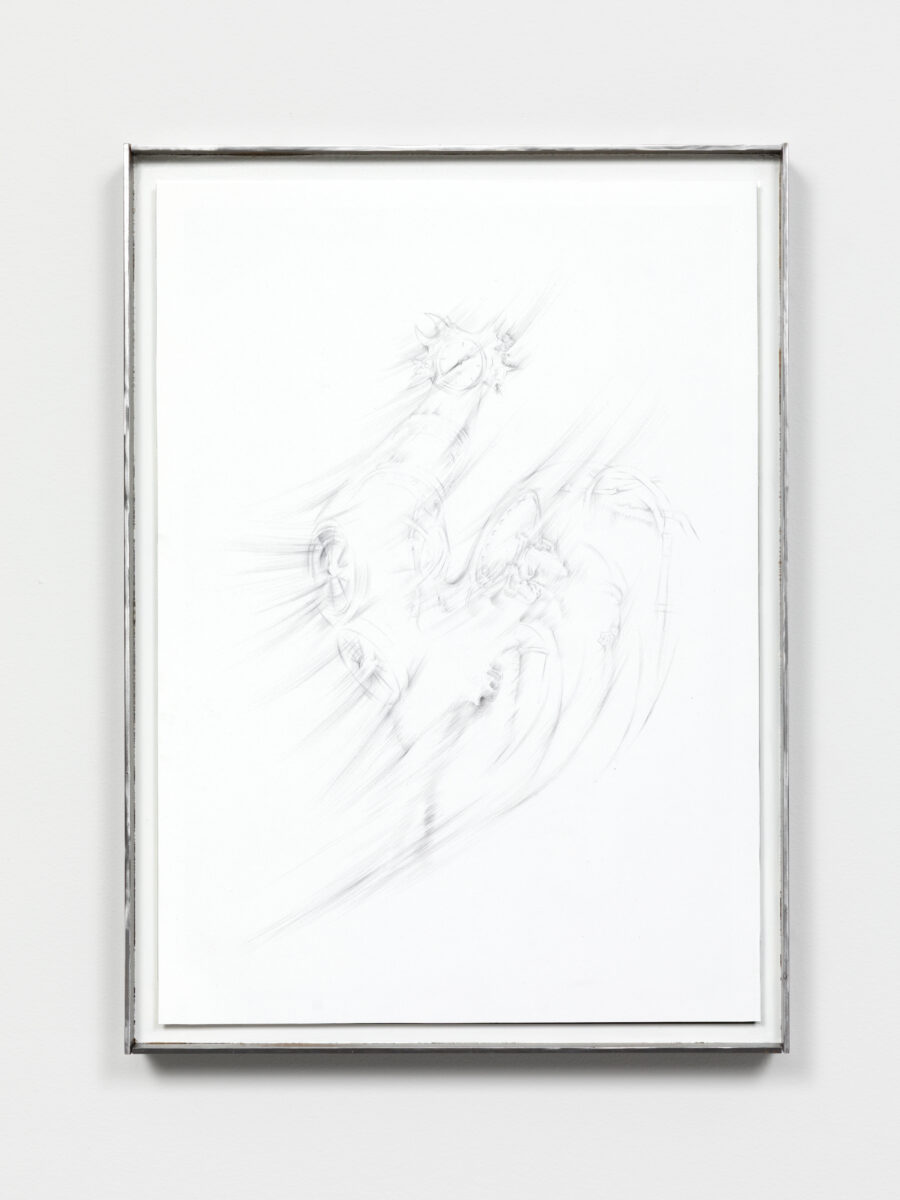
P.E.S.: In the exhibition at SARA’S, you are heavily investigating HVAC systems, circuits, lighting rods, and conductors. There is also a recurring theme of roosters, which would be seen on a weather vane. What binds these physical materials and the narratives behind them?
R.R.: In the show at SARA’S the overt linking theme in all my work is air. But it’s also about developments around the turn of the century specifically regarding the harnessing of air, either through ambient electricity in the atmosphere, or systems that process air for its regulation.
Both of the copper sculptures in the show explore patents for conductive balloons meant to harness electricity in the air that isn’t utilized. One patent is by Tesla in 1900 and the other built on this by Hermann Plauson patented in 1920. I became obsessed with the form of a balloon as this symbol of hope and ascension. In both cases, the balloon systems were never proven or fully manifested and testing led to treacherous ends.
The weathercock, which has become a motif for me, is a messenger between the heavens and earth. It responds to the wind to connect farmers with the air, to help them make predictions. I sort of think of it as the antithesis of HVAC systems, which is this mediation of air that creates a boundary between us and the atmosphere.
P.E.S.: During the Industrial Revolution inventors displayed their inventions at fairs, like the Coney Island Boardwalk or the World’s Fair. You’ve spoken about the magical qualities of the machines and inventions you research, and a sense of wonder around certain modern-day technological developments is still very present. How important is the engagement with the mysticism around machines, particularly the ones referenced in your show at SARA’S, that harness and manipulate natural elements such as air and energy? Do you feel that mysticism in the current moment, when weather and nature are again at the forefront of scientific innovation?
R.R.: Progress is now a dirty word because we have seen and are living in the horrors caused by the project of Modernity. I’m really interested in the World’s Fair because it illustrates these contradictions within the aesthetics of innovation and utopia. I’m very skeptical about the renewable energy industry. It’s all fundamentally the same frameworks that got us here. You can see this tension in the ad campaigns for rollouts of electric vehicles. I named my recent piece “Electric dream days are here” after a new Mercedes Benz ad. A lot of what I am doing is very critical of this kind of optimism, especially within tech.
But we do need this sense of wonder. Capitalism actively destroys enchantment with the world because it can only understand things as ingredients for the manufacturing of a valuable product.
In this context, cultivating a kind of magical lens that re-enchants objects and sees the world as an intricate web of mystical agents, feels radical.
P.E.S.: You have environmental concerns about weather systems and electricity usage; you are highlighting past promises and futuristic realities; you are even engaging with some of these materials, physically and digitally. What are some of the philosophies you hold towards your work and your use of media?
R.R.: Electricity and the digital are so often seen as these very clean and immaterial things. My engagement with them is that they are dirty, grimey. The more I work with electronics the more I have to acknowledge the material realities behind these seemingly non-physical worlds. I think until we really contend with this, we are never going to escape the ecological crises we are in. Weather is both a strong metaphor and very literal lens of the cycles of the earth that modern technologies largely ignore. I think in my work I am looking at invisible forces–the wind, air pressure, electric particles, electromagnetic waves–and trying to make them more visible.
To learn more about Rachel Rosheger, follow her on Instagram @rrosheger and visit her website, rachelrosheger.net.

